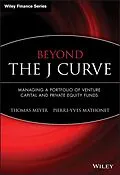In recent times, venture capital and private equity funds have become household names, but so far little has been written for the investors in such funds, the so-called limited partners. There is far more to the management of a portfolio of venture capital and private equity funds than usually perceived. Beyond the J Curve describes an innovative toolset for such limited partners to design and manage portfolios tailored to the dynamics of this market place, going far beyond the typical and often-simplistic recipe to 'go for top quartile funds'. Beyond the J Curve provides the answers to key questions, including: Why 'top-quartile' promises should be taken with a huge pinch of salt and what it takes to select superior fund managers? What do limited partners need to consider when designing and managing portfolios? How one can determine the funds' economic value to help addressing the questions of 'fair value' under IAS 39 and 'risk' under Basel II or Solvency II? Why is monitoring important, and how does a limited partner manage his portfolio? How the portfolio's returns can be improved through proper liquidity management and what to consider when over-committing? And, why uncertainty rather than risk is an issue and how a limited partner can address and benefit from the fast changing private equity environment? Beyond the J Curve takes the practitioner's view and offers private equity and venture capital professionals a comprehensive guide making high return targets more realistic and sustainable. This book is a must have for all parties involved in this market, as well as academic and students.
Autorentext
About the authors DR THOMAS MEYER studied computer science at the Bundeswehr Universität in Munich followed by doctoral studies at the University of Trier. He also holds an MBA from the London Business School. After 12 years in the German Air Force he worked for the German insurance group Allianz AG in Corporate Finance and M2.5 billion committed and almost 5 billion under management.
Inhalt
List of Boxes xv
Acknowledgements xvii
Disclaimer xviii
Part I Private Equity Environment 1
1 Introduction 3
1.1 Routes into private equity 3
1.2 The limited partner's viewpoint 4
1.3 The challenge of venture capital fund valuation 4
1.4 Hard figures or gut instinct? 5
1.5 Managing with fuzzy figures 5
1.6 Making the grades 5
1.7 Outline 7
2 Private Equity Market 9
2.1 Funds as intermediaries 10
2.2 The problem of predicting success 15
2.3 Broad segmentation of investment universe 18
2.4 Private equity market dynamics 22
2.5 Conclusion 26
3 Private Equity Fund Structure 27
3.1 Key features 29
3.2 Conflicts of interest 38
3.3 Finding the balance 38
4 Buyout and Venture Capital Fund Differences 41
4.1 Valuation 43
4.2 Business model 44
4.3 Deal structuring 45
4.4 Role of general partners 45
5 Funds-of-funds 47
5.1 Structure 47
5.2 Value added 48
5.3 Costs 51
5.4 Private equity investment programme 52
Part II Investment Process 57
6 Investment Process 59
6.1 Key performance drivers 59
6.2 Process description 61
6.3 Risk management 65
6.4 Tackling uncertainty 68
7 Risk Framework 73
7.1 Market value 75
7.2 Market or credit risk? 77
7.3 Conclusion 78
8 Portfolio Design 81
8.1 Portfolio design framework 81
8.2 Portfolio construction techniques 83
8.3 Riskreturn management approaches 88
9 Case Study 95
9.1 Looking for the optimal programme size 95
9.2 Overcoming entry barriers: long-term strategies 104
10 The Management of Liquidity 115
10.1 Liquidity management problem 115
10.2 Liquidity management approaches 123
10.3 Investment strategies for undrawn capital 130
10.4 Cash flow projections 133
10.5 Conclusion 145
Part III Design Tools 151
11 Established Approaches to Fund Valuation 153
11.1 Bottom-up approach to private equity fund valuation 154
11.2 Inconsistency of valuations 157
11.3 NAVs do not tell the full picture 157
11.4 Portfolio companies cannot be valued in isolation 159
11.5 Conclusion 162
12 Benchmarking 165
12.1 Specific issues 165
12.2 Individual funds 166
12.3 Portfolio of funds 170
13 A Prototype Internal Grading System 173
13.1 Grading of private equity funds 173
13.2 The NAV is not enough 174
13.3 Existing approaches 176
13.4 New approach to internal fund-grading system 180
13.5 SummaryNAV- and grading-based valuation 188
13.6 Conclusion 189
14 Fund Manager Selection Process 193
14.1 Relevance of fund manager selection 193
14.2 Why due diligence? 194
14.3 The due diligence process 195
14.4 Fund manager selection process 197
14.5 Decision and commitment 201
15 Qualitative Fund Scoring 219
15.1 Scoring approach 219
15.2 Scoring dimensions 221
16 Grading-based Economic Model 233
16.1 Approach 233
16.2 Internal age adjustment 237
16.3 Private equity fund IRR projections 238
16.4 Expected portfolio returns 239
16.5 Discussion 241
16.6 Conclusion 242
17 Private Equity Fund Discount Rate 253
17.1 The capital asset pricing model 253
